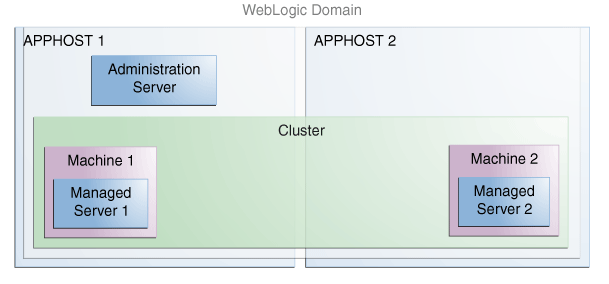2.3.3 Example of Building a Topology File
To start building a topology file, use the graphical tools to add and define the hosts and components in the workspace. You can then assign the components to the appropriate hosts.
This topic shows an example of the tasks required to create a topology file using Fusion Middleware Composer. Specifically, this example provides step-by-step instructions to create a topology for the Fusion Middleware multi-host environment shown in Figure 2-3.
This topology contains two hosts (APPHOST1 and APPHOST2). APPHOST1 contains the WebLogic Administration Server, a singe machine, and a single Managed Server, while APPHOST2 contains a second machine and second Managed Server. A cluster is shown encompassing both Managed Servers across both APPHOST1 and APPHOST2.
Figure 2-3 Example of an Orace Fusion Middleware Multi Host Topology

Description of "Figure 2-3 Example of an Orace Fusion Middleware Multi Host Topology"
Table 2-3 provides an overview of the tasks required to create a topology file for a multi-host environment.
Table 2-3 Tasks Required to Create a Topology File for a Multi Host Environment
| No. | Task | Example |
|---|---|---|
| 1 |
Create a new topology file. |
Creating a New Topology |
| 2 |
Identify a wallet file that will be used to hold environment credentials. |
Loading a Wallet File |
| 3 |
Add and define the hosts in your environment. |
Adding the Hosts |
| 4 |
Add and define the Oracle home(s) in your environment. |
Adding the Oracle Home |
| 5 |
Build and define the WebLogic domain in your environment, which typically includes an Administration Server and a cluster of Managed Servers. |
Building the WebLogic Domain |
| 6 |
Add and define the Node Managers in your environment. |
Adding the Node Managers |
| 7 |
Assign/Map the components to the appropriate hosts. |
Assigning Components to Hosts |